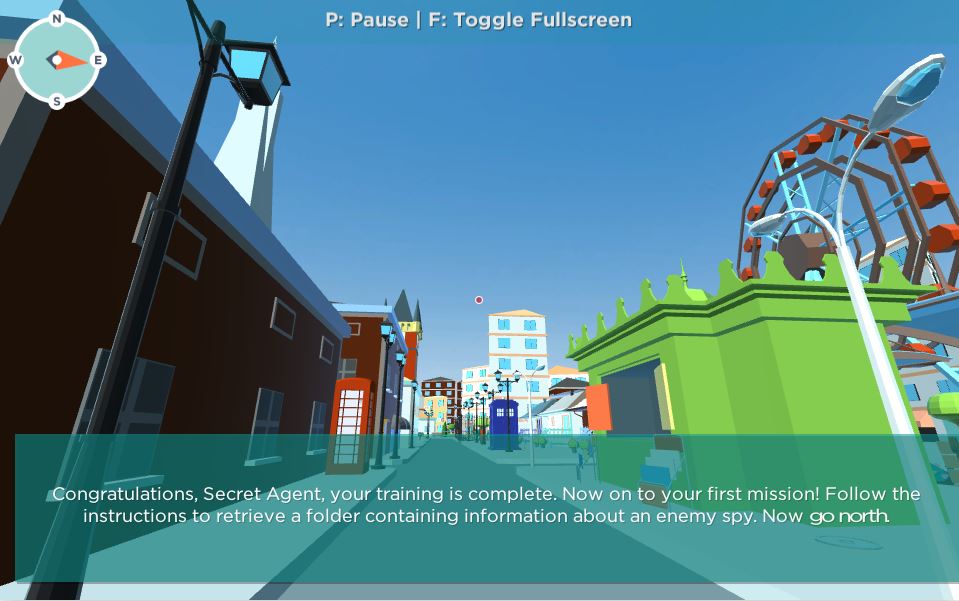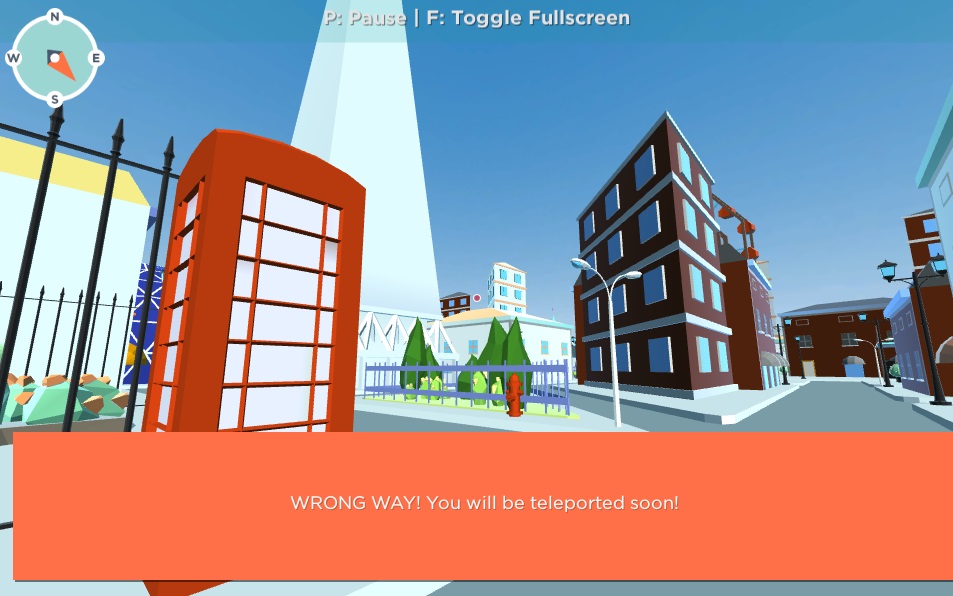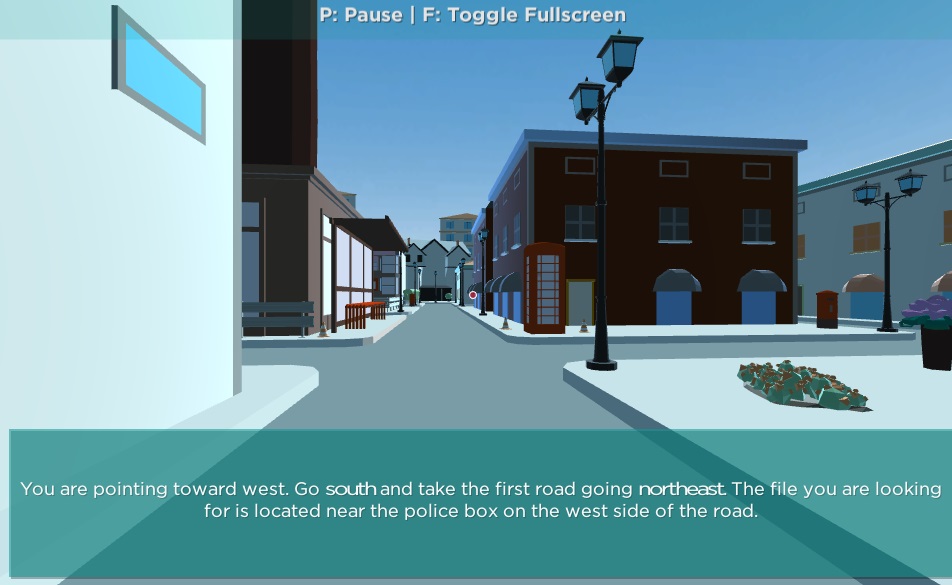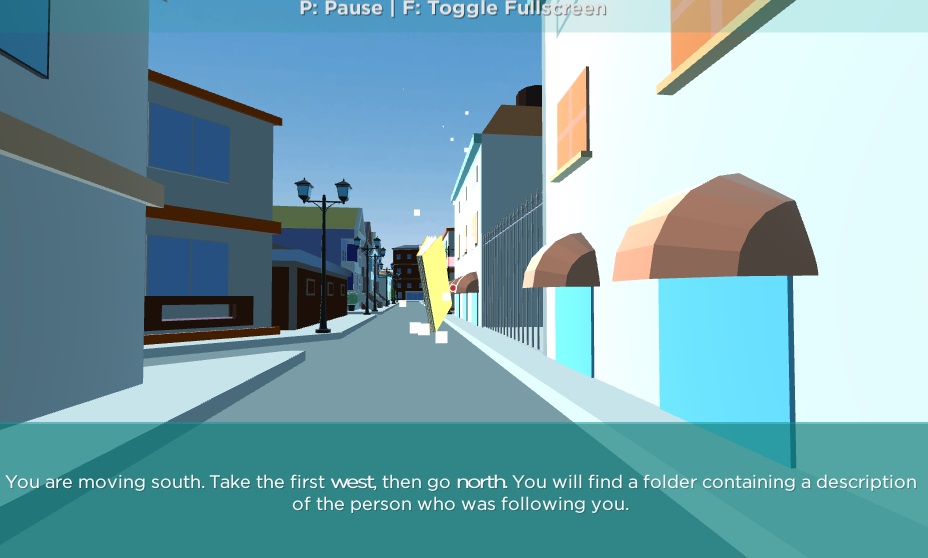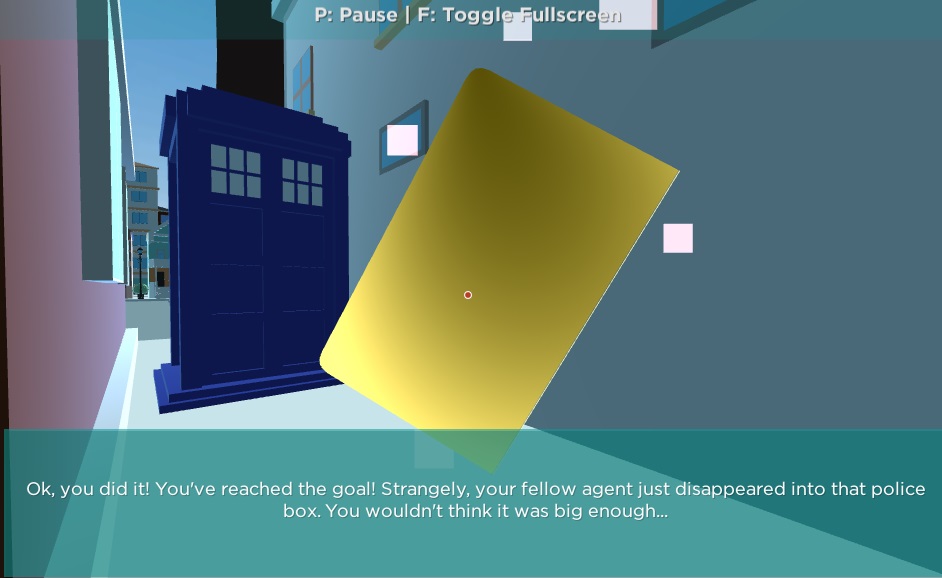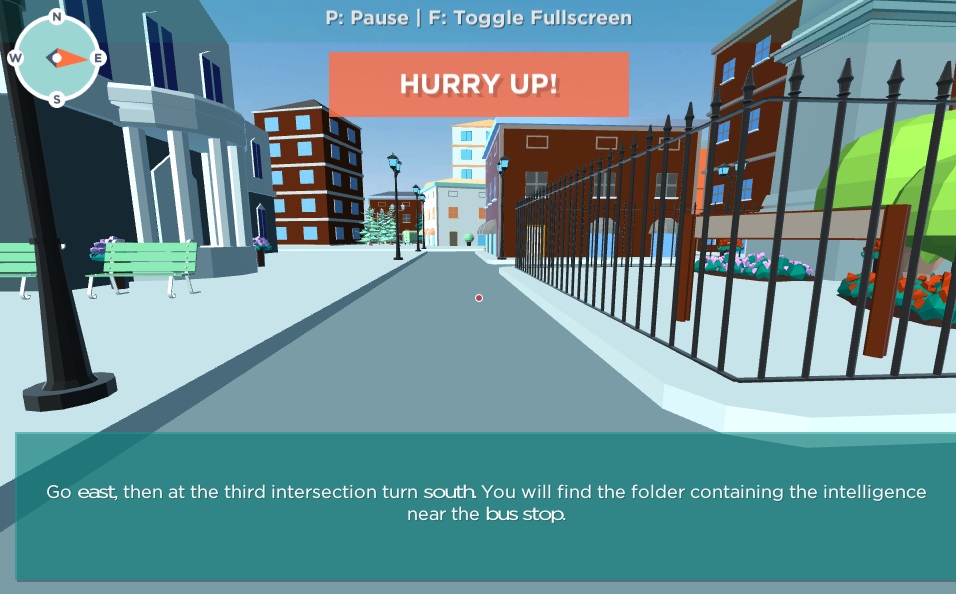Description
Example images from Orientation Direction missions are shown below. A written description of a mission now follows.
There were 5 Orientation Direction tests ('missions') in the Navigation battery. Each mission had the same rules and followed the same pattern of activity. Missions were further subdivided into a number of similar tasks: there were 6 tasks in every Orientation Direction mission except for mission 2, which had 4 tasks. In every task, twins were allowed up to 3 attempts to succeed in responding correctly. If the first attempt was successful, the task ended; if not, the task would begin again with the second attempt; and so on for the third attempt.
In each mission, twins were asked to follow a sequence of directions within the virtual world of the game (depicted as a town with streets and landmarks). The instruction for each new direction was provided on screen in the form of text such as 'you are now heading south, continue southwards and take the 3rd turning to the west'. Each such instruction was framed in terms of compass directions and sometimes turnings into side roads. Following one such instruction comprised one of the tasks of the mission. Hence, completion of the mission involved following a sequence of either 4 or 6 such instructions and hence completion of either 4 or 6 tasks.
Explicit feedback was provided at each stage in order to keep a twin moving towards the goal of completing the mission. As mentioned above, up to 3 attempts were allowed to complete each task, and success or failure in each attempt (or ultimately in each task) was implied by what happened on screen. An attempt was failed by moving in the wrong direction, contrary to the instruction; a warning message would then appear and, if not heeded, the twin would be "teleported" back to the start of the task for another attempt; or, after the 3rd attempt, would be taken to the start of the next task. Success in any attempt (and hence in the task) resulted simply in the appearance of instructions for the next task. In the last task of each mission, the instruction involved not just moving in a given direction but also reaching a target shown on screen as a group of sparkling dots surrounding an image of a revolving yellow folder; success was then signalled using text on screen.
To help twins in following the instructions in the first two missions, an image of a compass was always visible at the top-left of the screen, showing the direction in which the twin was currently facing or moving on the streets of the virtual world. However, the compass was not shown at all in missions 3, 4 and 5, making these missions more difficult.
Each Orientation Direction mission had a time limit of 180 seconds for completion of the tasks. There was no time limit on individual tasks or attempts within the mission. If the time limit expired before all the tasks had been completed, all remaining tasks and attempts were discontinued, the mission would come to an end, and the next mission in the battery would begin. There was no progress bar or timer on screen to help twins keep track of time; however, "hurry up" prompts appeared on screen as the time limit approached.
In order to respond in this type of mission, movement in the virtual world was achieved by holding down the mouse button to move forwards, and by moving the mouse to left or right in order to turn. If a twin did not make any input during the 180 second time limit of the mission (no mouse-down events), then the mission would time out without any meaningful response data being recorded. In these circumstances, with no input at all, the game would be 'auto-paused' when the time limit was reached, to prevent a sequence of missions from proceeding unattended and without input. After auto-pausing, a message would appear on screen, requiring the twin to click on a button in order to proceed to the next mission in the battery.
As in all other Navigation missions, twins could pause at any stage by pressing P on the keyboard; this would stop the clock and blank out the image of the streets. A further click on P would then resume the mission.
Because of the nature of Orientation Direction missions, it is not possible to reproduce the items (tasks) in any detail. However, the text instructions from each task in each mission is reproduced below in the Table of Test Items, and example images from missions are shown under the next heading.
Example Images
The images below are screen shots taken from Orientation Direction missions. These images serve as examples of how tasks were carried out and missions completed. Each task comprised an instruction (provided on screen as text) for following directions in terms of moving north, south, east and west and turning into side roads. The first image, below, shows the introductory screen from task 1 of mission 1; this task was simply to proceed north; the task was completed by moving northwards over some pre-determined distance. In tasks of Orientation Direction missions 1 and 2, as shown here, the compass is shown top-left (but note that the map is not shown at all). The compass was not shown in missions 3 to 5.
The next image (below) illustrates what happens when a twin proceeds in the wrong direction: a warning appears on screen as shown, giving the twin a brief opportunity to change direction. If the warning is ignored then the twin is "teleported" back to the starting point of the task, which uses up one of the three attempts; if all three attempts are failed then the twin is taken to the start of the next task.
The next image (below) illustrates a more complex task from mission 4. Note that here, and throughout missions 3, 4 and 5, the compass is not shown; hence, in missions 3 and 4, each instruction starts with a reminder of the current direction of view: 'You are pointing toward west.' (Such reminders were not given in mission 5.) The task here involves following a composite instruction: 'Go south and take the first road going northeast'. The instruction also indicates that this task is the last in the mission: 'The file you are looking for is located...'.
The next image (below) shows the appearance of the target at the end of the final task in a mission. From a distance, the target appears initially as a group of sparkling dots. As the target is approached nearer, a rotating yellow folder becomes visible. In order to complete the final task, and the mission, the twin had to keep moving until the target was reached.
The next image (below) illustrates the feedback given after successful completion of the last task and hence of the mission. The text at the bottom of the screen, which varies from mission to mission, indicates success. This text stayed on screen for a few seconds and then the next mission would begin.
The final image (below) illustrates the 'hurry up' prompt that appears as the mission time limit of 180 seconds approaches. This prompt repeatedly flashes on screen. If the mission is not completed within the time limit, then the mission simply ends without further feedback and the next mission begins.
Web Test Rules
All five Orientation Direction missions followed these rules:
- Tasks
Each mission comprised either 4 or 6 tasks. Subject to the timeout rule, all tasks in a mission were compulsory and were presented in a fixed order. - Attempts
Up to 3 attempts were allowed to complete each task. Each task ended either on successful completion or after 3 failed attempts. - Timeout rule
A timeout of 180 seconds applied to each mission. Within the 180 seconds allowed to complete the mission, there was no time limit on individual tasks or on individual attempts at each task. As the time limit approached, text warnings would appear on screen ('hurry up') but there was no other indication of the passing of time. When the mission timed out, it would simply end and the next mission would start. - Widgets
The compass remained on screen for the entire duration of every attempt of every task in missions 1 and 2. The compass did not appear during missions 3, 4 and 5. The map did not appear on screen at any time for any mission. - Pausing
The mission could be paused at any time by pressing P on the keyboard. The image of the virtual world was then replaced on screen by text explaining that the mission was paused, and that pressing P again would resume. Each mission could be paused indefinitely in this way, as often as a twin wished. - Auto-pausing
If a twin left a mission unattended for its entire duration, no input would be recorded and it would eventually time out. In these circumstances, in order to prevent a sequence of missions from timing out without input, an "auto-pause" would come into effect: the entire game was paused at the end of the mission, and the image of the virtual world on screen was replaced by explanatory text. A twin could then resume (at the start of the next mission) by clicking on a button. An Orientation Direction mission left unattended in this way was effectively forfeited, and was not presented again. - Attempt and task outcomes
The possible outcomes for each attempt in each task were as follows:- Success: directions followed correctly
- Failure: moved in an incorrect direction
- Second or third attempt skipped due to success in first or second attempt
- Attempt (or entire task) discontinued after mission timeout
- Timeout with no input on entire mission
Dataset Item Variables
The item variables relating to each Orientation Direction mission, as listed in the table below, were generated automatically by programs on the web server. For the sake of completeness, the table also lists derived variables relating directly to an Orientation Direction mission or its component tasks. Note that the dataset only includes data for completed missions. If a twin started a mission but left it unfinished, then the data for that mission were deleted from the dataset.
Note that the raw outcome variables for each attempt (rcnodXtYaZcm1/2, rcnodXtYaZer1/2) have been dropped from the dataset in favour of a single more informative outcome variable (rcnodXtYaZr1/2). The start and end dates/times have not been retained in the dataset.
In all variable names, X denotes the mission number (1 to 5), Y denotes the task number (1 to 6) and Z denotes the attempt number (1 to 3).
| Variables | Explanation | Values |
|---|---|---|
| rcnodXdata1/2 | Mission data flag: are mission data present? [DERIVED VARIABLE] | 0=no, 1=yes |
| rcnodXstat1/2 | Mission status: was the mission completed? [DERIVED VARIABLE] | 0=not started, 1=started but not finished, 2=finished successfully, 3=compromised by loss of data |
| rcnodXsttm1/2 | Start date and time of the mission [not in dataset] | Date-time values |
| rcnodXentm1/2 | End date and time of the mission [not in dataset] | Date-time values |
| rcnodXtime1/2 | Time interval from start to end of the mission [DERIVED VARIABLE] | Minutes (decimal values) |
| rcnodXdurn1/2 | Duration of actual activity during the mission | 0-180 seconds (decimal values) |
| rcnodXtYaZcm1/2 | Was attempt Z of task Y completed successfully? [DROPPED FROM DATASET] | 1=yes, 0=no |
| rcnodXtYaZer1/2 | Was an error made in attempt Z of task Y? [DROPPED FROM DATASET] | 1=yes, 0=no |
| rcnodXtYaZrt1/2 | Reaction time, from start of attempt to start of twin input, in attempt Z of task Y | Seconds (decimal values) |
| rcnodXtYaZct1/2 | Completion time, from start to end of attempt (whether completed or failed), in attempt Z of task Y | Seconds (decimal values) |
| rcnodXtYaZr1/2 | Coded outcome of attempt Z of task Y [DERIVED VARIABLE] | 1=completed successfully, 0=failed, -2=discontinued after mission timeout, -3=skipped after completion of earlier attempt in same task, -4=no input during the entire mission |
| rcnodXtYas1/2 | Accuracy score for task Y [DERIVED VARIABLE] | 0-3 (integer values) |
| rcnodXas1/2 | Mission accuracy score [DERIVED VARIABLE] | 0-1 (decimal values) |
| rcnodXss1/2 | Mission speed score [DERIVED VARIABLE] | 0-1 (decimal values) |
| rcnodXts1/2 | Mission total score [DERIVED VARIABLE] | 0-1 (decimal values) |
Table of Test Items
The table below gives the text instructions for each task in each Orientation Direction mission, and the feedback text given after successful completion of the final task. The table also shows whether or not the compass was displayed on screen during the mission. Within the instruction text for each task, the essential compass directions are highlighted with bold type.
| Mission | Compass? | Task | Text instruction |
|---|---|---|---|
| 1 | Yes | 1 | Congratulations, Secret Agent, your training is complete. Now on to your first mission! Follow the instructions to retrieve a folder containing information about an enemy spy. Now go north. |
| 2 | Turn east as soon as you can | ||
| 3 | Keep going east | ||
| 4 | Now turn north | ||
| 5 | Turn northwest | ||
| 6 | Now turn east and collect the files | ||
| feedback | Ok, you did it! The first page says, 'Haha, fooled you!', signed 'The Enemy Spy'. Hmm. It looks like you're not done yet! | ||
| 2 | Yes | 1 | The bishop (one of our master spies!) gave us intelligence regarding an advanced surveillance system used by a rival organisation. We will guide you to the exact location. Go east. |
| 2 | Turn south, then go northeast as soon as you can. | ||
| 3 | Now go south | ||
| 4 | Go east, then at the third intersection turn south. You will find the folder containing the intelligence near the bus stop. | ||
| feedback | You did it! | ||
| 3 | No | 1 | Someone is following you. Follow our instructions in order to lose them. You are now facing west. Go south, then southwest. |
| 2 | You are facing southwest. Go north and immediately turn west. | ||
| 3 | You are travelling west. Go straight ahead, and take the second north. | ||
| 4 | You are walking north. Keep going north and take the first road going southwest. | ||
| 5 | Well done! You are not being followed anymore. But there is still one thing to do. You are now facing southwest. Go west, then turn south. Act quickly! | ||
| 6 | You are moving south. Take the first west, then go north. You will find a folder containing a description of the person who was following you. | ||
| feedback | Ok, you did it! The person you were following was a heavily built older gentleman with a red suit and a long white beard. Apparently, you're on his list... | ||
| 4 | No | 1 | A fellow agent has dropped a file in a hidden location. You must collect the file to complete this mission. You are pointing south. Keep walking south and take the first west. |
| 2 | Now you are facing west. Keep going west and take the first road going northwest. | ||
| 3 | You are looking toward northwest. Go north and then take the first northwest. | ||
| 4 | You are walking toward the north-west. Now go north and take the second road going east. | ||
| 5 | You are now facing east. Take the second road going south and turn west. | ||
| 6 | You are pointing toward west. Go south and take the first road going northeast. The file you are looking for is located near the police box on the west side of the road. | ||
| feedback | Ok, you did it! You've reached the goal! Strangely, your fellow agent just disappeared into that police box. You wouldn't think it was big enough... | ||
| 5 | No | 1 | The cake's in the oven but it's not done yet, and neither are you. Our base is being kept under surveillance by enemy agents, so we must keep our communications to a minimum. Recover the documents showing the hidden camera locations. Your are facing north right now. Go east, then turn north, then take the first road going northeast. You are on your own, now. Good luck. |
| 2 | Now go south, then turn east, then south again. | ||
| 3 | Keep going south. Turn west at the fourth intersection. | ||
| 4 | Turn southeast as soon as you can, then walk west. | ||
| 5 | Go north, then at the second intersection turn west. | ||
| 6 | Go north and collect the documents on the west side of the road. | ||
| feedback | Perfect. Now we know where the hidden cameras are. Thank you agent! You have done an amazing job. |
